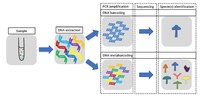
Freshwater zooplankton metapopulations and metacommunities respond differently to environmental and spatial variation.
Sign Up to like & getrecommendations! Published in 2020 at "Ecology"
DOI: 10.1002/ecy.3224
Abstract: Theory predicts that population genetic structure and metacommunity structure are linked by the common processes of drift and migration, but how population genetic structure and metacommunity structure are related in nature is still unknown. Deeper… read more here.
Keywords: variation; metacommunities respond; metapopulations metacommunities; structure ... See more keywords

Effects of Environmental and Spatial Variables on Bacteria in Zhanjiang Mangrove Sediments.
Sign Up to like & getrecommendations! Published in 2022 at "Current microbiology"
DOI: 10.1007/s00284-022-02774-z
Abstract: The bottom mud of mangroves contains numerous microbial groups that play an important role in the main ecological functions of the mangrove ecosystem. The diversity and functional and environmental factors related to microbial communities, in… read more here.
Keywords: diversity; effects environmental; environmental spatial; environmental factors ... See more keywords

Macrophyte functional groups elucidate the relative role of environmental and spatial factors on species richness and assemblage structure
Sign Up to like & getrecommendations! Published in 2018 at "Hydrobiologia"
DOI: 10.1007/s10750-018-3709-6
Abstract: We evaluated the relative importance of environmental and spatial factors on species richness and assemblage structure of macrophytes in 29 coastal wetlands in southern Brazil. We used variation partitioning on total assemblage and three functional… read more here.
Keywords: assemblage structure; assemblage; species richness; structure ... See more keywords

Unraveling the effects of water–sediment conditions and spatial patterns on Unionida assemblages in seasonally connected floodplain lakes
Sign Up to like & getrecommendations! Published in 2020 at "Hydrobiologia"
DOI: 10.1007/s10750-020-04290-2
Abstract: Floodplain lakes are good metacommunity systems to study the environmental and spatial processes structuring local assemblages. They are more connected during high-water periods and are more isolated during low-water periods. We evaluated the effects of… read more here.
Keywords: environmental spatial; spatial patterns; floodplain lakes; water ... See more keywords

Automatic harmonization of heterogeneous agronomic and environmental spatial data
Sign Up to like & getrecommendations! Published in 2019 at "Precision Agriculture"
DOI: 10.1007/s11119-019-09650-0
Abstract: The analysis and mapping of agronomic and environmental spatial data require observations to be comparable. Heterogeneous spatial datasets are those for which the observations of different datasets cannot be directly compared because they have not… read more here.
Keywords: heterogeneous spatial; acquisition conditions; environmental spatial; agronomic environmental ... See more keywords

The effects of dispersal ability on metacommunity structure of macroinvertebrates in subtropical Chinese high-mountain streams: seasonal shifts in relative contribution of local environment and spatial processes
Sign Up to like & getrecommendations! Published in 2021 at "Environmental Science and Pollution Research"
DOI: 10.1007/s11356-021-13281-2
Abstract: It is generally recognized that dispersal mode can affect the relative role of environmental and spatial factors in structuring biotic communities. Disentangling the effects of dispersal mode on metacommunity structuring is essential to understanding the… read more here.
Keywords: dispersal mode; environmental spatial; metacommunity; spatial processes ... See more keywords

The Importance of Environmental and Spatial Factors in the Metacommunity Dynamics of Exposed Sandy Beach Benthic Invertebrates
Sign Up to like & getrecommendations! Published in 2017 at "Estuaries and Coasts"
DOI: 10.1007/s12237-017-0263-9
Abstract: We studied the contribution of environmental and spatial factors in determining the metacommunity dynamics of benthic macroinvertebrates in ocean-exposed sandy beaches. A combination of different metacommunity models contributed to the structure of the benthic species,… read more here.
Keywords: exposed sandy; beach; metacommunity; spatial factors ... See more keywords

Environmental and spatial assessment for the ecodesign of a cladding system with embedded Phase Change Materials
Sign Up to like & getrecommendations! Published in 2017 at "Energy and Buildings"
DOI: 10.1016/j.enbuild.2017.09.011
Abstract: Abstract New building materials and techniques are increasingly developed to respond to the challenges posed by the need of reducing energy demand of buildings while keeping adequate answer to housing needs. The potential of Cement… read more here.
Keywords: assessment; change materials; environmental spatial; phase change ... See more keywords

Environmental and spatial drivers of spider diversity at contrasting microhabitats
Sign Up to like & getrecommendations! Published in 2017 at "Austral Ecology"
DOI: 10.1111/aec.12488
Abstract: The relative importance of environmental and spatial drivers of animal diversity varies across scales, but identifying these scales can be difficult if a sampling design does not match the scale of the target organisms' interaction… read more here.
Keywords: spider assemblages; spatial drivers; diversity; distance ... See more keywords

Non‐linear models of species' responses to environmental and spatial gradients
Sign Up to like & getrecommendations! Published in 2022 at "Ecology Letters"
DOI: 10.1111/ele.14121
Abstract: Abstract Species' responses to broad‐scale environmental or spatial gradients are typically unimodal. Current models of species' responses along gradients tend to be overly simplistic (e.g., linear, quadratic or Gaussian GLMs), or are suitably flexible (e.g.,… read more here.
Keywords: species responses; models species; environmental spatial; spatial gradients ... See more keywords